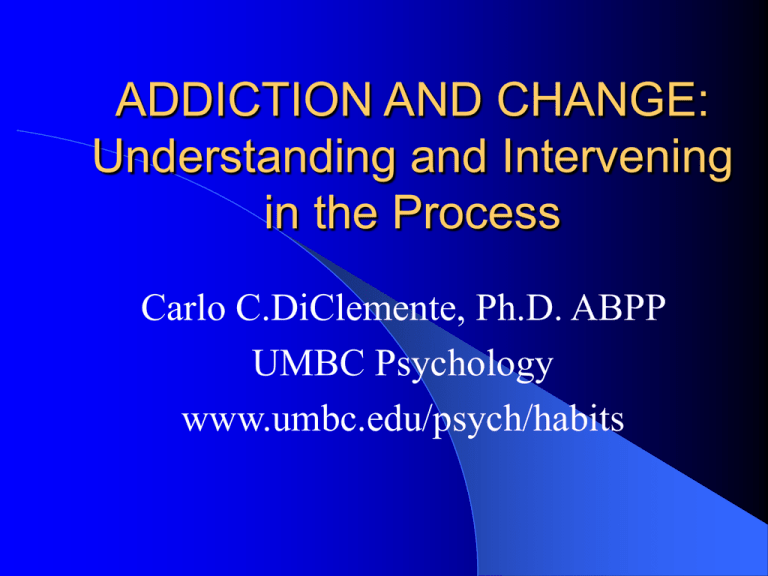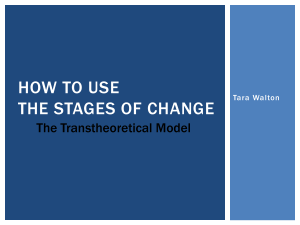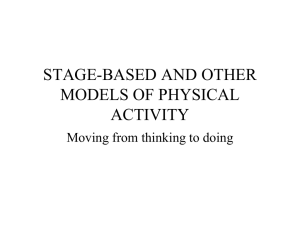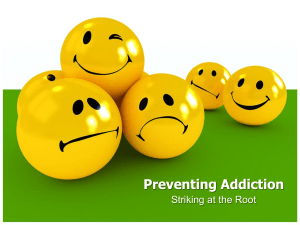
ADDICTION AND CHANGE:
Understanding and Intervening
in the Process
Carlo C.DiClemente, Ph.D. ABPP
UMBC Psychology
www.umbc.edu/psych/habits
What are Addictions?
Habitual patterns of intentional, appetitive
behaviors
Become excessive and produce serious
consequences
Stability of these problematic behavior
patterns over time
Interrelated physiological and psychological
components
Addicted individuals have difficulty
modifying and stopping them
Traditional Models for
Understanding Addictions
Social/Environmental Models
Genetic/Physiological Models
Personality/Intra-psychic Models
Coping/Social Learning Models
Conditioning/Reinforcement Models
Compulsive/Excessive Behavior Models
Integrative Bio-Psycho-Social Models
Change the Integrating
Principle
No
single developmental model or
singular historical path can explain
acquisition of and recovery from
addictions
A Focus on the Process of Change and
how individuals change can bring
together different perspectives
Personal Pathways to Change
Are
influenced by personal decisional
considerations and choices
Personal choices are influenced by and
influence genetic, characterological,
and social forces
There is an interaction between the
individual and the surrounding risk and
protective factors
BECOMING ADDICTED
Happens
over a Period of Time
Has a Variable Course
Involves a Variety of Predictors
that can be both Risk and
Protective Factors
Involves a Process of Change
SUCCESSFUL RECOVERY
FROM ADDICTIONS
Occurs
over long periods of time
Often involves multiple attempts and
multiple treatments
Consists of self change and/or
treatment
Involves changes in other areas of
psychosocial functioning
Addiction and Change
Both acquisition of and addiction and
recovery from an addiction require a
personal journey through an intentional
change process that is influenced at
various points by the host of factors
identified in the previous reviewed
etiological models.
Involves a Process of Change
How Do People Change?
People change voluntarily only when they
– Become concerned about the need for change
– Become convinced that the change is in their
best interests or will benefit them more than
cost them
– Organize a plan of action that they are
committed to implementing
– Take the actions that are necessary to make the
change and sustain the change
The Transtheoretical Model of Intentional Behavior Change
STAGES OF CHANGE
PRECONTEMPLATION CONTEMPLATION PREPARATION
ACTION MAINTENANCE
COGNITIVE/EXPERIENTIAL
PROCESSES OF CHANGE
BEHAVIORAL
Consciousness Raising
Self-Revaluation
Environmental Reevaluation
Emotional Arousal/Dramatic Relief
Social Liberation
Self-Liberation
Counter-conditioning
Stimulus Control
Reinforcement Management
Helping Relationships
CONTEXT OF CHANGE
1.
2.
3.
4.
5.
Current Life Situation
Beliefs and Attitudes
Interpersonal Relationships
Social Systems
Enduring Personal Characteristics
MARKERS OF CHANGE
Decisional Balance
Self-Efficacy/Temptation
Model Components (Stages)
1. Precontemplation - Not Ready to Change
2. Contemplation - Thinking About Change
3. Preparation - Getting Ready to Make Change
4. Action - Making the Change
5. Maintenance - Sustaining Behavior Change Until
Integrated into Lifestyle
Relapse and Recycling - Slipping Back to Previous
Behavior and Re-entering the Cycle of Change
Termination - Leaving the cycle of change
Tasks and goals for each of
the Stages of Change
PRECONTEMPLATION - The state in which
there is little or no consideration of change of
the current pattern of behavior in the
foreseeable future.
TASKS: Increase awareness of need for
change and concern about the current pattern
of behavior; envision possibility of change
GOAL: Serious consideration of change
for this behavior
The “Five R’s” of How and Why
People Stay in Precontemplation
Reveling
Reluctant
Rebellious
Resigned
Rationalizing
Tasks and goals for each of
the Stages of Change
CONTEMPLATION – The stage where the
individual examines the current pattern of
behavior and the potential for change in a risk
– reward analysis.
TASKS: Analysis of the pros and cons of
the current behavior pattern and of the costs
and benefits of change. Decision-making.
GOAL: A considered evaluation that leads
to a decision to change.
Decisional Balance Worksheet
NO CHANGE
CHANGE
PROS (Behavior)
_______________
_______________
_______________
CONS (Behavior)
_______________
_______________
_______________
CONS (Change)
_______________
_______________
_______________
PROS (Change)
_______________
_______________
_______________
Tasks and goals for each of
the Stages of Change
PREPARATION – The stage in which the
individual makes a commitment to take
action to change the behavior pattern and
develops a plan and strategy for change.
TASKS: Increasing commitment and
creating a viable, realistic, change plan.
GOAL: An action plan to be
implemented in the near term.
Tasks and goals for each of
the Stages of Change
ACTION – The stage in which the individual
implements the plan and takes steps to change the
current behavior pattern and to begin creating a
new behavior pattern.
TASKS: Implementing strategies for change;
revising plan as needed; sustaining commitment in
face of difficulties
GOAL: Successful action to change current
pattern. New pattern established for a significant
period of time (3 to 6 months).
Tasks and goals for each of
the Stages of Change
MAINTENANCE – The stage where the new
behavior pattern is sustained for an extended period
of time and is consolidated into the lifestyle of the
individual.
TASKS: Sustaining change over time and
across a wide range of different situations. Avoiding
slips and relapse back to the old pattern of behavior.
GOAL: Long-term sustained change of the old
pattern and establishment of a new pattern of
behavior.
Stage of Change Tasks
Precontemplation
Contemplation
Preparation
Action
Maintenance
Awareness,
Concern,Confidence
Risk-Reward Analysis
& Decision making
Commitment &
Creating an
Effective/Acceptable
Plan
Adequate
Implementation of Plan
and Revising as Needed
Integration into
Lifestyle
Regression, Relapse and
Recycling through the Stages
Regression represents movement backward
through the stages
Slips are brief returns to the prior behavior that
represent failures of action or the action plan
Relapse is a return to re-engagement in the
previous behavior to a significant degree after
initial success
After returning to the prior status quo behavior,
individuals re-enters pre-action stages at
precontemplation, contemplation, or preparation
and may feel like a failure and discouraged about
her ability to change
Reasons for Relapse
Lack of Willpower
Environmental Pressures
Situational Cues
Inadequate skills
Lack of Support for Sobriety
Problematic Self-Efficacy
Part of the Process of Change
Theoretical and practical considerations related
to movement through the Stages of Change
Motivation
Precontemplation
Personal Environmental
Concerns Pressure
Decision-Making
Contemplation
Decisional
Balance
(Pros & Cons)
Preparation
Cognitive
Experiential
Processes
Recycling
Self-efficacy
Action
Maintenance
Behavioral
Processes
Relapse
Stages of Change Model
Precontemplation
Awareness of need to change
Contemplation
Increasing the Pros for Change
and decreasing the Cons
Preparation
Commitment & Planning
Relapse and
Recycling
Maintenance
Integrating Change into
Lifestyle
Termination
Action
Implementing and
Revising the Plan
THE STAGES OF CHANGE FOR ADDICTION AND RECOVERY
ADDICTION
Dependence
PC
C
PA
A
M
PROCESSES, CONTEXT AND MARKERS
OF CHANGE
PC
Dependence
C
PA
RECOVERY
A
M
Sustained
Cessation
THE COURSE OF ADDICTION
DEPENDENCE
ABUSE
REGULAR USE
REGULAR USE
CASUAL
CASUALUSE
USE
EXPERIMENTATION
EXPERIMENTATION
Theoretical and practical considerations related
to Prevention and Stages of Initiation
Expectancies/Beliefs
Precontemplation
Decision-Making
Contemplation
Personal Environmental Decisional
Concerns Pressure
Balance
(Pros & Cons)
Experimentation
Preparation
Cognitive/
Experiential
Processes
Casual use
Self-efficacy
Action
Maintenance
Behavioral
Processes
Regular Use
Dependence
Implications for Acquisition
and Prevention
If there is a common but unique pathway,
we can better understand where individuals
are in this process of change for each
addictive behavior
We can distinguish between prevention and
treatment better
We can target interventions to the process of
change
PREVENTION OF INITIATION OF ADDICTION
PC - C
C - PA
POPULATION
PREVENTION
PA - A
AT- RISK
PREVENTION
A-M
ALREADY
AFFLICTED
A STAGE BY ADDICTIVE BEHAVIOR PERSPECTIVE ON
ALLEN
TYPE OF
BEHAVIOR
STAGE OF INITIATION
PC
C
PA
X
X
MARIJUANA
COCAINE
AMPHETAMINES
X
X
X
X
LSD
GAMBLING
EATING DISORDER
M
X
ALCOHOL
NICOTINE
HEROIN
A
X
X
2000 Cross-sectional Data:
Q85 How many of your four closest friends
smoke?
4.00
2.87
3.00
2.54
1.95
2.00
1.06
1.00
0.45
0.00
Mean
PC
C
P
A
M
2000
STATEWIDE
Middle School
High School
PC
C
P
A
M
74.5%
55.2%
20.4%
24.4%
2.6%
5.9%
1.5%
5.0%
1.1%
9.5%
2002
STATEWIDE
Middle School
High School
PC
C
P
A
M
77.6%
59.5%
18.6%
24.4%
1.9%
5.0%
1.1%
4.3%
0.8%
6.8%
Change: 2002-2000
STATEWIDE
Middle School
High School
PC
C
P
A
M
3.1%
4.3%
-1.8%
0.0%
-0.7%
-0.9%
-0.4%
-0.7%
-0.3%
-2.7%
Q55: % who would smoke a cigarette if
offered by best friend
100
94.8
88.6
87.8
94.8
87.9
87.3
82.9
80.7
80
95.9
94.9
76.1
73.4
60
40
25.5
24.9
23.6
22.7
20
0
1.1
1.2
0.9
2000
2002
1.1
2000
Middle School
PC
2002
High School
C
P
A
M
Key Issues In Prevention
Know where individuals are in the process of
initiation
Create credible messages that do not do more
harm than good
Target high risk individuals in the preparation and
action stages who are at highest risk
Focus on the context of change not simply the
behavior
Realize that individuals are in different stages with
regard to different problematic and positive
behaviors
The Well-Maintained Addiction
Defining action and maintenance is critical
for initiation of health risks, like addiction,
as well as health protection behaviors
Regular, dependent use of a substance that
creates creates a pattern that eludes selfregulatory control, continues despite
negative feedback, and becomes an integral
part of the individual’s life and coping
Theoretical and practical considerations related to
movement through the Stages of Change
Motivation
Precontemplation
Personal Environmental
Concerns Pressure
Decision-Making
Contemplation
Preparation
Decisional
Balance
(Pros & Cons)
Cognitive
Experiential
Processes
Self-efficacy
Action
Recycling
Maintenance
Behavioral
Processes
Relapse
STAGES OF CHANGE AND THERAPIST TASKS
PRECONTEMPLATION
Raise doubt - Increase the client’s perception of
risks and problems with current behavior
CONTEMPLATION
Tip the decisional balance - Evoke reasons for
change, risks of not changing; Strengthen client’s
self-efficacy for change of current behavior
PREPARATION
Help the client to determine the best course of
action to take in seeking change; Develop a plan
ACTION
Help the client implement the plan; Use skills;
Problem solve; Support self-efficacy
MAINTENANCE
Help the client identify and use strategies to
prevent relapse; Resolve associated problems
RELAPSE
Help the client recycle through the stages of
contemplation, preparation, and action, without
becoming stuck or demoralized because of relapse
Key Issues In Interventions
Coercion, Courts and Mandated Treatment
Family Frustration and Interventions
Confrontation breeds Resistance
Motivation not simply Education needed
Intrinsic and Extrinsic Motivations
Proactive versus Reactive Approaches
Harm Reduction and Motivation
Pregnancy Smoking
Cessation
Many addicted pregnant smokers stop
smoking for the pregnancy
Stopping is not quitting
Motivation for postpartum cessation differs
Change motivation is baby focused and
NOT for self
Imposed change
Special Issues for Drug Courts
and Mandated Assessment & TX
Accurate assessment: Initiation or Recovery
Critical Distinctions:
– Extrinsic and Intrinsic Motivations
– Consequences and Punishment versus
Motivation and Change
– Mandated Treatment versus Mandated Change
Clear Communication between Legal
System and Intervention System
Approaches that Pay Attention
to the Process of Change
Clearly identify the target behavior
Evaluate stage of readiness to change
Evaluate beliefs and practices related to target
behavior
Examine routes and mechanisms of influence in
the culture and for the individual
Create sensitive stage based multi-component
interventions
Re-evaluate regularly the process of change
Processes of Change
Change engines that enable movement
through the stages of change
Doing the right thing at the right time
Cognitive/behavioral processes during early
stages
Behavioral processes in preparation, action
and maintenance
Processes of Change
Experiential Processes
–
–
Concern the person’s thought processes
Generally seen in the early Stages of Change
Behavioral Processes
–
–
Action oriented
Usually seen in the later Stages of Change
Transtheoretical Model:
Experiential Processes of Change
Consciousness Raising: Gaining information increasing
awareness about the current habitual behavior pattern or the
potential new behavior
Emotional Arousal: Experiencing emotional reactions about
the status quo and/or the new behavior
Self –Revaluation: Seeing when and how the status quo or the
new behavior fit in with or conflict with personal values
Environmental Reevaluation: Recognizing the effects the
status quo or new behavior have upon others and the
environment
Social Liberation: Noticing and increasing social alternatives
and norms that help support change in the status quo and/or
initiation of the new behavior
Transtheoretical Model:
Behavioral Processes of
Change
Self Liberation: Accepting responsibility for and committing
to make a behavior change
Stimulus Control: Creating, altering or avoiding cues/stimuli
that trigger or encourage a particular behavior
Counter-Conditioning: Substituting new, competing
behaviors and activities for the “old” behaviors
Reinforcement Management: Rewarding sought after new
behaviors while extinguishing (eliminating reinforcements)
from the status quo behavior
Helping Relationships: Seeking and Receiving support from
others (family, friends, peers)
PROCESSES OF CHANGE by STAGE
STAGES
PC
P
R
O
C
E
S
S
E
S
C
PA
A
M
Consciousness raising
Self-reevaluation
Dramatic relief
Helping relationship
Self- liberation
Contingency
management
Counterconditioning
Stimulus control
CONTEXT OF CHANGE
I. SITUATIONAL RESOURCES AND PROLBLEMS
II. COGNITIONS AND BELIEFS
III. INTERPERSONAL RESOURCES/PROBLEMS
IV. FAMILY & SYSTEMS
V. ENDURING PERSONAL CHARACTERISTICS
Stages by Context Analysis
PreC Cont
Prep
Action Maint
1. Sit
2. Cog
Experiential Processes
3. Rel
4. Sys
5. Per
Behavioral Processes
TRANSITIONS THROUGH THE
STAGES OF ADDICTION FOR ALLEN:
Potential Complicating Problems
CONTEXT OF
CHANGE
STAGE OF CHANGE TRANSTIONS
PC
C C
PA PA
A
SPECIFIC BEHAVIORAL &
SITUATIONAL ISSUES
BELIEFS &
EXPECTANCIES
Soft vs.
Hard Drugs
School
(Family, Employment, Social) success
ENDURING PERSONAL
CHARACTERISTICS
M
Multiple
Addictions
Religious
beliefs
Sex &
alcohol
Girlfriend/
Intimacy
INTER
PERSONAL
SOCIAL SYSTEMS
A
Brother &
Peers
Peers
Risk
taking
Parental
smoking
TRANSITIONS THROUGH THE
STAGES OF RECOVERY FOR ALLEN:
Potential Complicating Problems
CONTEXT OF
CHANGE
STAGES OF CHANGE
PC
C
C
PA
Soft vs.
hard drugs
(Family, Employment, Social)
ENDURING PERSONAL
CHARACTERISTICS
A
Sex &
alcohol
Girlfriend/
Intimacy
INTER
PERSONAL
SOCIAL SYSTEMS
A
Seeking
Help
SPECIFIC BEHAVIORAL &Multiple
SITUATIONAL ISSUES
Addictions
BELIEFS &
EXPECTANCIES
PA
Peers
Brother &
Peers
Impulsive
AA
Work
M
Difficult Clients and Client Difficulties:
A TTM Analysis
Target Problem and Contextual Problems
Stage of Change for Each Problem
Identifying Key Processes of Change
Finding Appropriate Strategies to Engage
Processes
Recycling and Learning from the Past
Accomplishing Stage Tasks Adequately
Project MATCH: Alcohol
Impairment at Baseline
Outpatient
Aftercare
Percent of Days Abstinent
34.3
26.8
Drinks per Drinking Day
13.5
20.5
No. of SCID Symptoms
Prior IP Alcohol Treatment
Number of Participants
5.77
6.79
45.0%
58.3%
952
774
100
90
80
70
60
50
40
30
20
10
0
Mean Percent Days Abstinent as a
Function of Time (Outpatient)
-2 -1 0
4
5
6
CBT
7
8
9 10 11 12 13 14 15
MET
TSF
TTM Profile: Outpatient PDA Baseline
0.8
Standard Scores
0.6
0.4
Abstinent
Moderate
Heavier
0.2
0
-0.2
-0.4
-0.6
-0.8
Pre
Con
Act
Main
TTM Variables
Conf
Temp
TTM Profile: Outpatient PDA Post Treatment
0.8
Standard Scores
0.6
0.4
Abstinent
Moderate
Heavier
0.2
0
-0.2
-0.4
-0.6
-0.8
Pre
Con
Act
Main Conf Temp
TTM Variables
Exp
Beh
TTM Profile: Aftercare PDA Baseline
0.8
Standard Scores
0.6
0.4
Abstinent
Moderate
Heavier
0.2
0
-0.2
-0.4
-0.6
-0.8
Pre
Con
Act
Main
TTM Variables
Conf
Temp
TTM Profile: Aftercare PDA Post Treatment
0.8
Standard Scores
0.6
0.4
Abstinent
Moderate
Heavier
0.2
0
-0.2
-0.4
-0.6
-0.8
Pre
Con
Act
Main Conf Temp
TTM Variables
Exp
Beh
PROCESS OF
INTENTIONAL
BEHAVIOR
CHANGE
TREATMENT
CLIENT
THERAPIST
PROCESS OF
FORMAL
INTER
CHANGE
VENTIONS









